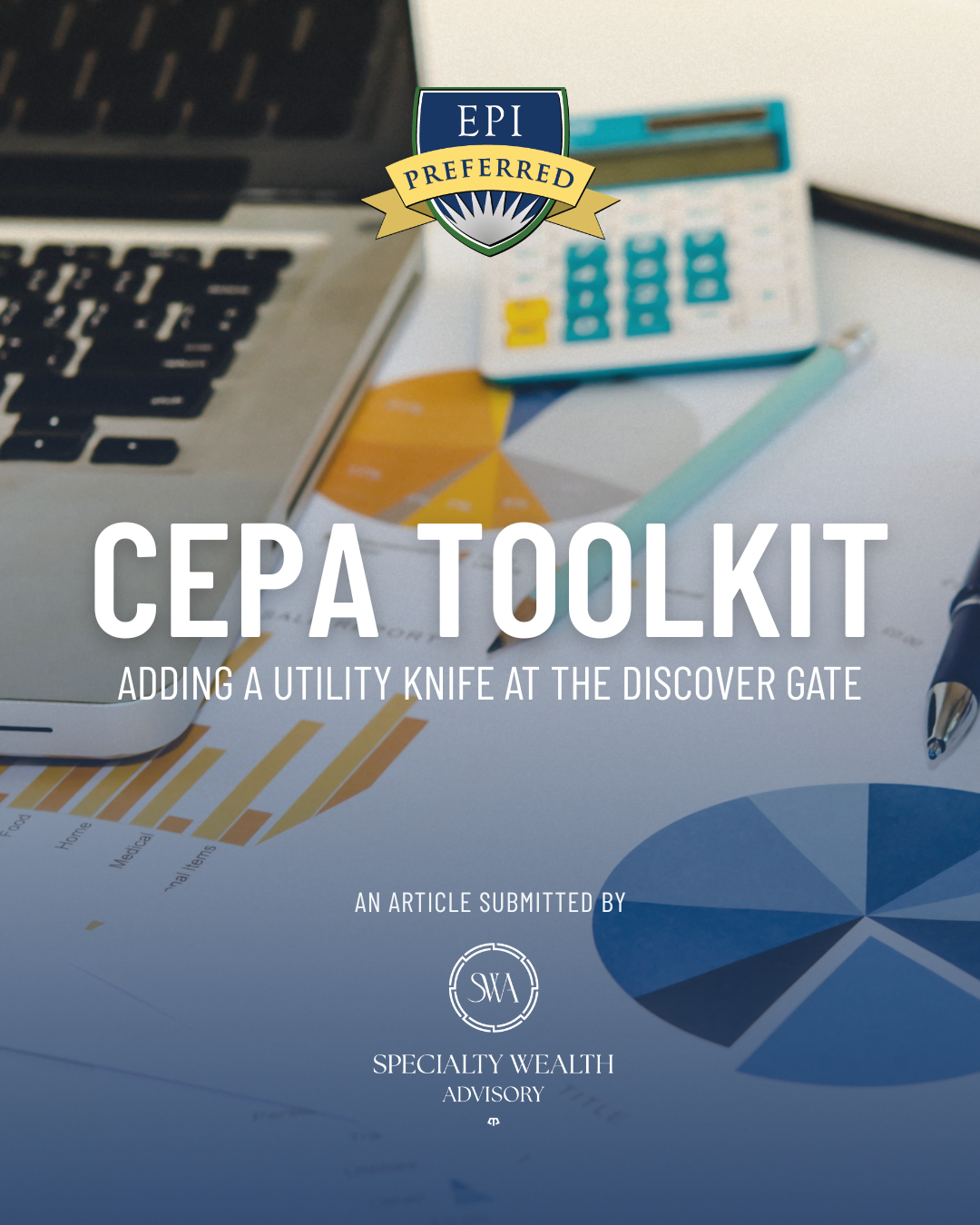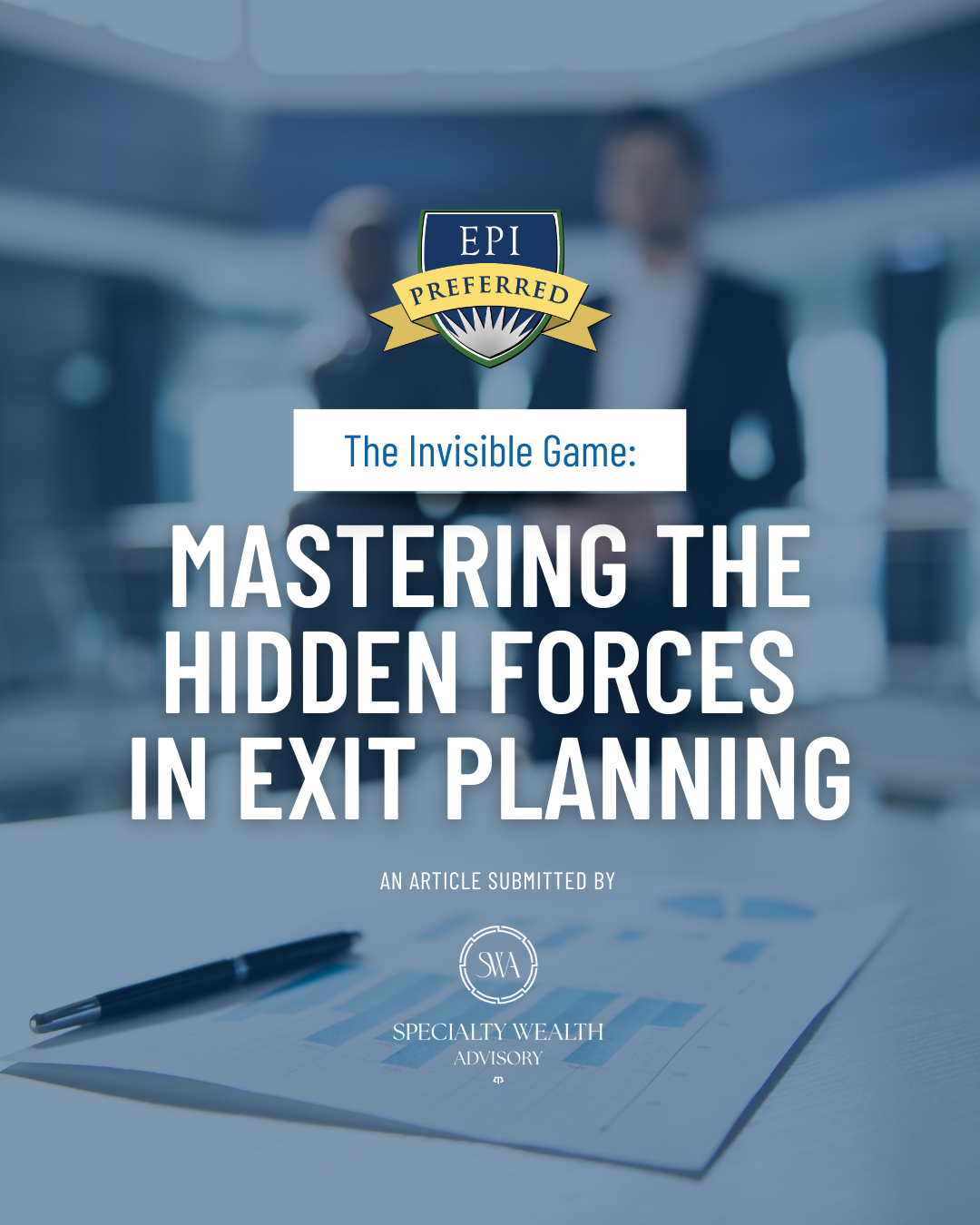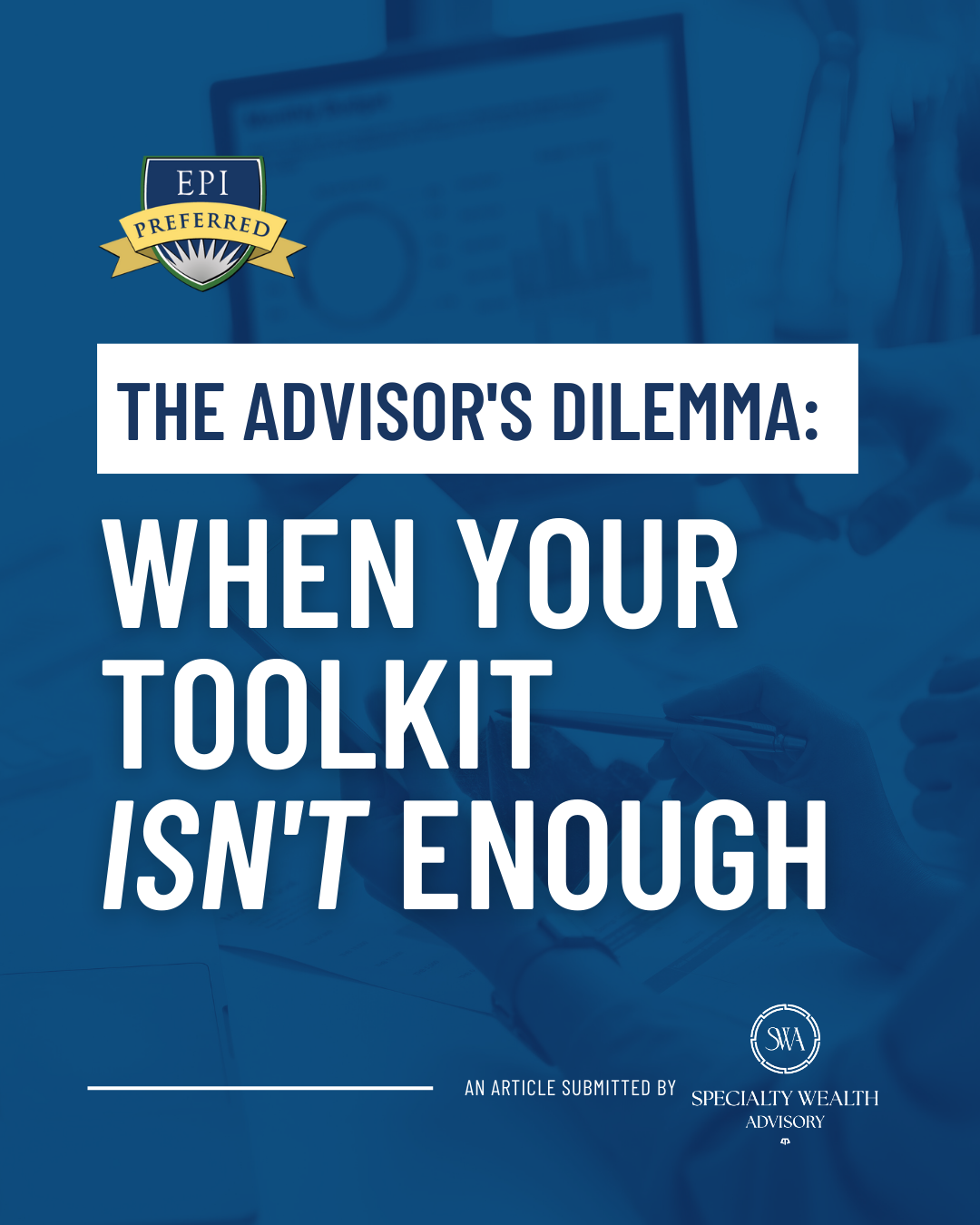
THE EXIT PLANNING BLOG
Keep up-to-date with exit planning, succession planning, industry trends, unique specialty insights, and useful content for professional advisors and business owners.
Share this
CEPA Toolkit: Adding a Utility Knife at the Discover Gate
by Partner Contributed Article on February 21, 2024

Since the beginning of 2000, high net worth families have worked with the world's leading law firms in developing custom-designed private placement variable universal life insurance policies (PPLI) to provide a complete life insurance solution for their families (a wide array of benefits to their loved ones) and for charities. These policies have been sold via the use of Regulation D “private placement” documents or “PPMs” for securities law purposes. These customized insurance policies are frequently funded with a combination of cash and certain non-cash assets which can include interests in private equity, real property, hedge funds, artwork, aircraft, and qualifying majority-owned entities via in-kind contribution1. This design can afford an excellent exit planning opportunity for CEPA’s, particularly at the end of the EPI Discover Gate, which is the first phase of exit planning.
Overview of In-Kind Premiums
Many CEPA’s are unaware that assets such as interests in private business entities and real estate holding companies (“Non-bankable Assets”) or “in-kind” premiums are readily accepted by life insurance companies whose primary market focus is high-net-worth clients seeking customized client-centric insurance protection plans. For this reason, advisors and their clients miss a variety of the tax planning solutions that can lead to greater protection and significantly greater tax-advantaged wealth accumulation over the lifetime of the policyholder.
When it comes to the purchase of life insurance, the term “premium” represents the total amount of fiat currency and other considerations (excluding interest on policy loans) that are paid in exchange for the issuance of life insurance policy and the policy benefits2. These in-kind or non-cash premiums become part of the policy’s cash value within the PPLI policies. These non-cash premiums are invested within the policy and receive the same tax treatment as other types of assets held within any compliant policy, as recently determined under an IRS private letter ruling3.
The National Association of Insurance Commissioners (“NAIC”) follows this long-standing acceptance of in-kind assets for both casualty and life insurance policies, and goes even further, avoiding any specifically enumerated definition of Premium and In-Kind Premiums within their publications and issuances of regulatory guidance4
The Facts
Donny Donnelly, age 45, is a high-net-worth entrepreneur who founded a successful retail donut store chain (Donnelly’s Delicious Donuts) and now wants to sell the chain. He is a resident of California and is in the top marginal bracket for Federal and State tax purposes. Donny’s advisor, Julia, is a CEPA and is nearing the end of the Discover Gate in her work with Donny.
While the valuation of Donny’s company was $10 million at the time of the Discovery Gate planning, Julia believed that it could be worth $40 million or more in a few years, after fully integrating Value Acceleration Methodology planning.
The Problem
Julia recognized that the sale of Donny’s company would trigger millions of dollars in Federal and State taxes. She also recognized that if he died before selling, the value of the business could stagnate or even plummet, leaving the Donnelly family in a financial lurch.
The Solution
With the assistance of his attorney, Donny established a Grantor Trust. The Trust is the applicant, owner, and beneficiary of a $25 million curated PPLI policy. Donny funded the Trust using his exemption equivalent for estate and gift tax purposes. The policy features a customized investment account with an independent Manager who was nominated by Donny. Donny, Julia, and the Manager develop a broad investment policy that comports with Donny’s risk level, timing, and planning objectives. The Manager controls the investment discretion under the investment policy. Donny has no ability to control the investment discretion.
The policy obtained the right to acquire Donnelly’s Delicious Donuts in the future for $15 million5. Any monetization of the business above that value could be earned inside the policy and accorded the same tax-advantaged treatment as any other asset in the policy.
Five years later, Donny sold his company for $57 million. Of that amount, $42 million was received inside of the PPLI policy. Importantly, there are a variety of tax implications inherent to this strategy, and there are legal and policy governance requirements, including those related to diversification and investor control, that must be maintained on an ongoing basis for policy compliance. Fortunately, these guidelines are well established and can be maintained by professionals with a deep acumen in advanced PPLI.
Where to Begin?
CEPA’s may struggle to find a team of attorneys, advisors, and an insurance carrier with the sophistication and expertise to handle curated in-kind premiums. The reality is that the bespoke PPLI marketplace is a niche marketplace with a small and finite number of sophisticated advisors to handle transactions involving in-kind premiums. Most life insurance agents, including brokers who promote “on the shelf” PPLI products, don’t have this knowledge.
Fortunately, a handful of advisors are deeply experienced and proficient at designing customized life insurance solutions for successful business entrepreneurs of all types, including business builders like Donny, large real estate holders, and private equity investors. They typically work closely with regional and national law firms, and they have the expertise to develop curated policy designs in support of CEPAs and their client’s overall wealth accumulation and exit strategies.
This ensures all aspects of in-kind premium transfer and policy ownership - including the proper valuation of in-kind assets, adherence to the Investor Control Doctrine, investment diversification, and the determination and accessibility of efficiently priced mortality coverage.
CEPA’s can work closely with these advisors to evaluate planning outcomes as part of their client engagements. Models can be designed to calculate possible outcomes, confirming if any given planning strategy best serves their client. Ideally, the analysis should be completed by the end of the Discovery Gate, prior to the creation of additional business value through the Value Acceleration Methodology. Doing so can afford cost savings on significant life insurance benefits, along with planning outcomes that may otherwise be unattainable.
Summary
Curated or “bespoke” PPLI planning offers CEPA’s the ability to provide exit planning clients with the flexibility and customization that is absent with retail life insurance. Advanced planning affords exit planning clients with the ability to fund bespoke life insurance policies with low basis capital assets holding the potential for substantial capital appreciation.
Brad Barros is a Director at Private Risk Partners, LLC. For more information, he can be reached at BBarros@privateriskpartners.com or through JSellers@privateriskpartners.com.
Notes
1 See example PLR 8427085; PLR 201436005; PLR 201240018; PLR 200915006; PLR
9433030; PLR 8427091;
Rev. Rul. 82-55; Rev. Rul. 82-54, and Rev. Rul. 2003-91.
2 See Section 7702(f)(1).
3See PLR 202041005 (July 13, 2020) accepting a life insurance company as the owner of real estate and operating partnership where the investment strategy is sufficiently broad and there is no agreement between the insurer and the policyholders as to what assets in the cash value may be bought or sold). The ruling is nonpublished and of no precedential value.
4 These include the following publications and model regulations issued by the NAIC including: (i) Variable Insurance Model Regulation MDL-270; (ii) Variable Annuity Model Regulation MDL-250; (iii) Model Variable Contract Law MDL-260; (iv) Life and Health Insurance Policy Language Simplification Model Act MDL-575; (viii) Universal Life Insurance Model Regulation MDL-585; (viii) Annuity Nonforfeiture Model Regulation MDL- 806; (ix) Standard Nonforfeiture Law for Life Insurance MDL-808; and (x) Valuation of Life Insurance Policies Model Regulation MDL-830.
5 A compliant transaction requires tax and regulatory guidance. Clients should seek assistance from independent tax counsel.
Learn more about Specialty Wealth Advisory here.
About the Author

Brad Barros brings over 35 years of leadership in risk mitigation, adept at resolving complex issues and pioneering industry advancements. His extensive experience includes founding and steering various life and casualty insurance entities, launching a global joint venture with a "Big 8" NYSE-listed CPA firm, and establishing two national consulting firms that offer customized strategies for AI risk management and sophisticated tax solutions tailored to family offices, high-net-worth individuals, and professionals in entertainment and sports.
An alumnus of the University of Delaware, Brad is passionately committed to philanthropy, actively supporting the B+ Foundation and Casey Cares Foundation.
For more information, he can be reached at BBarros@privateriskpartners.com or through JSellers@privateriskpartners.com.
Related Resources
Share this
- Blog (545)
- CEPA (420)
- exit planning (249)
- CEPA community (187)
- Business Owner (169)
- Exit Planning Summit (95)
- EPI Chapter Network (89)
- Value Acceleration Methodology (79)
- Exit Planning Partner Network (76)
- EPI Announcement (49)
- Content (48)
- Webinars (37)
- Excellence in Exit Planning Awards (33)
- Marketing (30)
- 2024 Exit Planning Summit (28)
- 5 Stages of Value Maturity (26)
- Books (24)
- EPI Academy (24)
- Exit Planning Teams (22)
- EPI Team (21)
- Leadership (21)
- 2023 Exit Planning Summit (20)
- family business (20)
- women in business (19)
- Intangible Capital (18)
- Exit Options (17)
- Black Friday (16)
- CPA (15)
- Walking to Destiny (15)
- State of Owner Readiness (14)
- Chapters (13)
- Chris Snider (12)
- National Accounts (12)
- Small business (12)
- charitable intent (12)
- personal planning (12)
- Financial Advisors (11)
- Season of Deals (9)
- 5 Ds (8)
- About us (8)
- Podcast (8)
- Insiders Bash (7)
- Scott Snider (7)
- Christmas (6)
- Exit Planning Content Library (6)
- Case Studies (5)
- Owner Roundtables (5)
- Value Advisors (5)
- financial planning (5)
- Awards (4)
- Circle of Excellence (4)
- Exit & Succession (4)
- Five Ds (4)
- Three Legs of the Stool (4)
- executive training (4)
- Owners Forum (3)
- author (3)
- forbes (3)
- DriveValue (2)
- EPI Thought Leadership Council (2)
- Exit Is Now Podcast (2)
- Peter Christman (2)
- Veteran (2)
- Whitepapers (2)
- Business Owners Forum (1)
- SOOR (1)
- business consultants (1)






